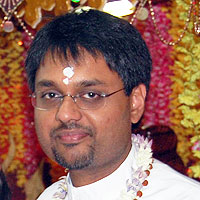Pundit Umesh Persad, Spiritual Leader, Gyaan Deepak Kirtan Mandali
The Bhagavad Gita, chapter 4 explains the nature of Brahma and sacrifice:
Brahmarpanam Brahma havir
Brahmagnau Brahmana hutam
Brahmaiva tena gantavyam
Brahma-karma-samaadhina
Brahma is that Supreme Spirit, arpanam is an offering. In the practice of seeing Brahma everywhere as a form of sacrifice, Brahma is the ladle with which the offering is poured into the fire. Brahma is the offering. Brahma is the fire. Brahma itself is the sacrificer. Brahma itself is the act of offering. And, Brahma is the goal to be reached by one who is absorbed in Brahma. For those devotess who are completely absorbed in God consciousness, one who sees Brahma in everything, can easily attain Brahma.
There is a well-known analogy related to this verse that states that we are like drops of water that will eventually return to the ocean. However, it must be noted that the water has always been a part of the ocean and the essence of the ocean itself is in a drop of water. In the ocean there are also waves, foam and bubbles that all consist of water; and they return to the ocean as water. Thus, everything in this creation is one. Yet, we think of ourselves as separate and limited. We think of ourselves as one among many. The ultimate goal is to understand that we are One Consciousness, not only from a conceptual level, but also from an experiential level; there is a difference between intellectual knowing and the deep knowledge of experience. Every spiritual practice will lead us to the knowledge that we are all one in essence. Like fish in the ocean, we are born and live in the ocean yet we look around and wonder, where is the ocean? Where is God? Let us search for Him. However, just as the wave does not understand it is the ocean, just as the fish does not understand that it is in the ocean, the human being does not understand that he or she is one with God. This is the essence of Hindu philosophy.
The saint Kabir says that in the householder life, it is difficult to understand this concept. If everything is God and we are in God, that One Consciousness, then we would not be able to find God because He is everywhere. Instead, understand that the true knowledge of the self is already found; it is already what we are. The problem lies with the quality of our mind. We can listen to scriptural teachings but disagree because of our own mind, our ingrained beliefs. Others might listen and try to understand while some might understand it very deeply.
It is said that without atma gyaan, knowledge of the Self, this world is like a dream. Atma gyaan is a constant awareness that we are not a limited person; we are the Supreme Spirit that is always in existence. When we visit holy places such as Mathura and Kaashi (which means ‘crystal clear’), it really means that we should exist with the knowledge that we are just not this body-mind but also pure spirit. Kabir also urges that we should put the name of Raam in our heart. In Sanskrit, a name tells you the quality associated with the form it represents. Raam means ‘shining’ or ‘self-effulgent’. In this context, heart means the subtlest of existence everywhere. It means relaxing into your own true nature, realising that you are that shining Raam always.
Moreover, the self, atma or soul is not within the body; there is one Supersoul and it contains the body. This feeling of ‘I-ness’ that we have is maya or illusion. When we are in the deep sleep state without dreams, we do not identify as our body or our limited identity of the self. The limitation of individuality is a product of the mind’s imagination. This is the highest philosophy of every religion and spiritual path. Do not accept the notion that there is something superior inside us as compared to outside us. The true self is neither inside nor outside. We are everywhere. We are not our mind and thoughts. We are the witness of our mind and thoughts.
We may think we are the body and mind, but one day, we will drop these, like baggage, and only the true Self will remain. To illustrate this point, there was once a man who tried to bury his shadow, so he dug a hole in the ground. As he was standing outside the hole, his shadow was cast into it. He covered the hole with dirt in order to bury his shadow. However, as expected, he failed, as the shadow was not physical. Similarly, we take our self, our mind and thoughts to be real. We might try to fight it or bury it but no matter what we do, the mind will still exist. If we really wish for liberation we just have to understand that we are not the mind. It is the highest truth to be understood. Like the water in the ocean, we must eventually realise that our presence and consciousness is everywhere.



